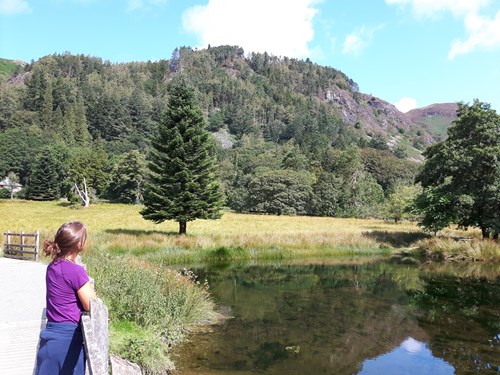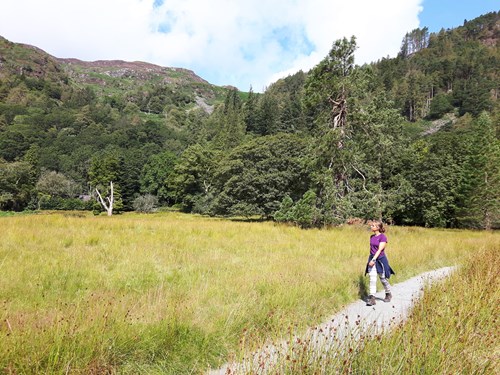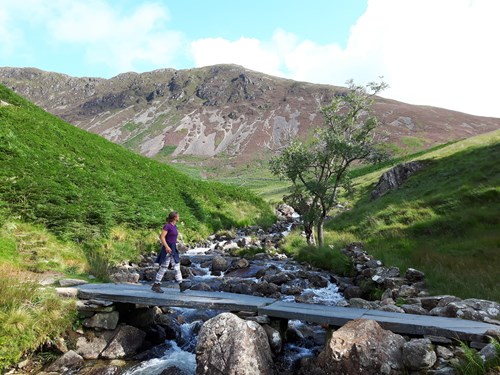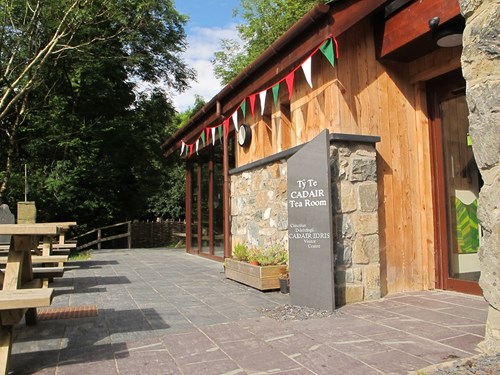Beddgelert Forest, near Beddgelert
Peaceful forest in the heart of Snowdonia National...
Cadair Idris National Nature Reserve is made up of a range of mountains in the south of Snowdonia National Park.
The visitor centre and tea room are in Dôl Idris parkland which lies in the foothills of Cadair Idris.
There are accessible paths around Dôl Idris parkland and two short but steep waymarked trails from the visitor centre into the reserve.
The Minffordd Path to the summit of Cadair Idris also sets off from the visitor centre.
The main access to Dôl Idris parkland and Cadair Idris National Nature Reserve is from a car park just off the A487.
The Dôl Idris Lake and Parkland Circuit walking trails are waymarked from the car park and follow flat paths in the parkland.
The Gorge Climb and Nant Cadair Bridge walking trails climb steeply from the visitor centre onto the National Nature Reserve, and follow part of the Minffordd Path.
These four walking trails are waymarked from start to finish.
Look out for the information panel at the start of the trails.
Find out about walking trail grades.
This circular route starts from the car park and goes all the way around the lake in the parkland.
Look out for birds such as the dipper and grey wagtail, which breed on the lakeshore, and the fish ladder near the footbridge that helps salmon to reach the streams.

This circular route passes through the parkland with its exotic specimen trees and alongside the visitor centre.
Look out for the ruined building where Idris table water and ginger beer were first made and the visitor centre bat boxes.

Follow the maroon symbols from just past the visitor centre up the steep gorge to a bench with views across to the waterfall.
The route goes through the ‘Celtic Rainforest’ with its range of internationally important species of moss.

Follow the orange symbols from just past the visitor centre on a long steep climb up the gorge.
The trail goes past the waterfalls, where there’s a bench to catch your breath.
It then continues onto the lower slopes of the open mountain to the Nant Cadair slate bridge.

A network of paths lead up and around Cadair Idris National Nature Reserve, meeting on the summit at Penygadair.
Footpaths are mainly well defined and easy to follow but visibility can change quickly and it is advisable to carry a map and compass at all times.
There is a shelter at the top of Cadair Idris for use during inclement weather.
Even in summer the temperature at the top can be several degrees lower than in the car park. Low cloud often covers the summit, so it can be damp as well as cold.
This route is 6 miles to the summit and back.
It is the shortest route up Cadair Idris but also the steepest.
This very strenuous climb starts just past the visitor centre on a long flight of very steep rocky steps.
It is not waymarked and you need a map, navigational skills and a good level of fitness to attempt this route.
Please note:
Cadair Idris Visitor Centre is 300 metres from the car park on a wide level path.
The visitor centre has an exhibition about the wildlife, geology and legends of Cadair Idris.
The exhibition includes:
Tŷ Te Cadair Tea Room is in the same building as the visitor centre.
The visitor centre and tea room are open seasonally - see opening times below or go to the Tŷ Te Cadair Tea Room Facebook page.

Please check the top of this page for any changes to these opening times.
The visitor centre and tea room is normally open every day 10am to 5pm from Good Friday to 16 September.
The visitor centre and tea room may close during the week in bad weather.
Please check the Tŷ Te Cadair Tea Room Facebook page or ring 01654 761505 before travelling for updates to opening times.
The toilets in the visitor centre are open when the centre is open.
The toilets in the car park are managed by the Snowdonia National Park Authority and are open daily (not 24 hours).
The car park is managed by the Snowdonia National Park Authority.
For information about opening times and parking charges go to the Snowdonia National Park Authority website.
Facilities include:
Sometimes we need to close or divert trails for your safety whilst we undertake maintenance work or other operations.
We may have to close a site in extreme weather, such as high winds or snow and ice, due to the risk of injury to visitors or staff.
Please always follow any instructions on site and any temporary diversion signs.
A walk through Cadair Idris National Nature Reserve is like climbing a ladder from habitat to habitat, from a fertile valley to the rocky peak of one of Wales’s highest mountains.
You will ascend from the classic U-shaped Tal-y-llyn valley through a steep gorge, to a hanging valley at Cwm Cau.
Above lie the cliffs of Craig Cau and the Penygadair summit, with their bare jagged rocks.

If you’re lucky, you may spot peregrine falcons hunting above the high crags, or a shy ring ouzel in the steep rocky ravines.
Wheatears return to the mountain too, whilst chiffchaffs and willow warblers can be heard singing all around the visitor centre at the foot of the reserve.
Many woodland plants such as primrose and wood anemone come into flower, and the oaks show signs of bursting into life again.
Summer sees the welcome return of the classic trio of Welsh oakwood birds: pied flycatcher, wood warbler, and redstart, as well as the swallows and housemartins that often nest under the visitor centre eaves.
On the cliffs in early summer, arctic-alpine plants are at their best, some of which are seen nowhere further south in Wales.
In flower at the same time is the locally rare hairy greenweed that grows here at it's northernmost location!
Later the dry slopes are clothed in a carpet of purple heather, punctuated here and there by the yellow flowers of western gorse. The bogs glisten with the sticky sundews, accompanied by bog ashopodel and heath spotted orchids, whilst dragonflies patrol their patches.
The rare lesser horseshoe bats return to their breeding roost in the roof of the visitor centre and, in the exhibition, you can watch live infrared footage of the females nursing their young in July.
The dense canopy of the Celtic rainforest takes on its rich seasonal tapestry of colours, and a wealth of fungi produce their fruiting bodies on the woodland floor.
The increased rain swells Nant Cadair stream, raising the humidity in the gorge under the shade of the trees, making conditions ideal for a variety of very rare mosses and liverworts.
With fewer visitors on the mountain it is a good time to explore the reserve. Look for the dainty flowers of ivy-leaved bellflowers and wild thyme. Choughs occasionally visit the grassy slopes to forage for insects and grubs with their stunning red curved beaks.
The hardier butterflies such as peacocks still emerge to feed on fine days, along with the odd bilberry bumblebee, an uncommon upland species with its seemingly bright red rump!
Winter is a good time to appreciate the stunning geology of Cadair Idris.
The valley of Cwm Cau is a classic result of the last ice age, with sheer cliffs, a thousand feet tall at one point, almost encircling Llyn Cau, one of Wales' deepest natural lakes. It is said to be bottomless, with a monster lurking within! You may not ever see this mysterious creature, but if you are very lucky, you could possibly see a stoat in its white winter coat, hunting its prey amongst the screes.
Elsewhere on the reserve, you can see other clues to the sites' geological past such as pillow lavas and smooth rock faces, scoured by the slow moving iceflow.
National nature reserves are places with some of the very finest examples of wildlife habitats and geological features.
There are over 70 National Nature Reserves in Wales.
Find out more about National Nature Reserves
Local folklore describes Idris as a giant who lived on this magnificent mountain; Cadair Idris is Welsh for “Idris's chair”.
The large boulders on the lower slopes are supposed to be the debris from stone throwing battles between Idris and the other giants.
It is said that if you are lucky enough to survive a night on the summit, the ordeal will either drive you mad or turn you into a poet.
This film is bi-lingual. The Welsh version plays first and the English version follows after seven minutes.
Cadair Idris is 10 miles south of Dolgellau.
It is in the county of Gwynedd.
Cadair Idris is on Ordnance Survey (OS) map Explorer OL 23.
The OS grid reference is SH 732 115.
The main access to Cadair Idris is via the Dôl Idris car park.
Take the A487 from Dolgellau towards Machynlleth and turn right onto the B4405.
The entrance to the Dôl Idris car park is immediately on the right.
The nearest mainline railway station is in Tywyn.
Bus services run from Tywyn.
Buses also run on the A487 and stop at the junction with the B4405 near the car park.
For details of public transport visit the Traveline Cymru website.
The main access to Cadair Idris is via the Dôl Idris car park.
This car park is on the B4405, just off the A487 between Dolgellau and Machynlleth.
The car park is managed by the Snowdonia National Park Authority.
There is a parking charge.
For information about opening times and parking charges go to the Snowdonia National Park Authority website.
enquiries@naturalresourceswales.gov.uk